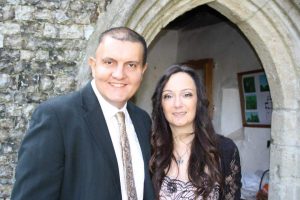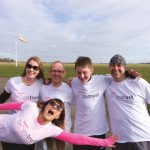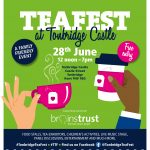Here Paula Middleton recounts her families story, how she and her husband wrote Toby the Teapot – to help children understand when their parent has a brain tumour.
A quote from Iggy Pop!
Do you miss David Bowie?
“I try not to be sad but use the
Gifts he gave me….”
In October 2011 our journey in life took a dramatic change. Sitting in the hospital room at Kings, London we waited for the door to open and in entered the most coldest Clinical Nurse we had met on our Journey. As we looked up we heard the words “sorry you have a Brain Tumour, and if you don’t have it removed and treatment you will be dead in six months, luckily you’re not in a small village and you are here and able to have treatment”. We asked how long Richard had and were told “one to two years, five if your lucky”. These words will always stay with me, thankfully the Clinical Nurse no longer works in Kings, this always stayed with Richard, but he always tried to make a joke of it. From that moment I knew I had to be strong and support both my little girl, our family and the bravest Man I know.

When we heard these words I expect some of you can empathise with the response and shock we felt inside, tears started to flow and sadness poured in. The first thought our little daughter T: what are we going to tell her? My heart sank, I needed to be strong for her and my dearest, amazing husband Richard.
Richard then went onto have an eleven-hour operation to remove the tumour and nearly passed due to a bleed but pulled through with strength, courage, determination and prayer as we were both Christians at the time. He knew he wanted to fight for T and me and our family. I will never forget the anxiety and worry I experienced that night and how brave my husband was and continued to be.
We found out after he was taken off the ventilator in ITU that he had a Glioblastoma grade 4, the worst grade you could have.
I remember waiting with him near the operating theatre, the surgeon said do you have any allergies and Richard said with his quirky sense of humour “Yes nuts, hopefully you won’t give me a Cornetto, when I come round or there will be problems!”.
We didn’t know anything about a Brain Tumour so our first thought was to get as much information as we could to support us as a family. We were advised to go to the Macmillan Centre and pick up some leaflets, and were told there should be a children’s book for T. As we looked around it was scary, we picked up one leaflet after another, I asked the lady about a children’s book, she just said “Sorry we don’t have anything, you can maybe look on Amazon or Google it”.
From that moment on our lives took a new direction in so many ways, but do you know what, boy did we appreciate everyday more and the little things we did for each other as a family, which we took for granted before and I’m sure whoever is reading this will resonate with what I’m saying.
Life changed forever
When we got home with Richard’s new medication and a couple of leaflets, the fact that I had no clue what a Brain Tumour was, Google became my new best friend. I headed up stairs and sobbed into my pillow and from that moment on I started to grieve for so many things: the old life I had and the pain Richard had just endured and what we will all go through as a family together.
During the next month the post got very busy with white envelopes dropping to the floor, ‘oh no not another appointment letter and the official operation date’, my husband as usual was in good spirits and was glad to be home seeing our little girl.
During the weeks spent at home I noticed Richard’s dressing had stains on it, he said he wasn’t feeling great and I noticed his temperature was rising. Me being me and not leaving things, I pulled back his dressing – it was red and weeping. I thought, oh no, its infected. It was a Saturday and the Doctors Surgery was shut so I called Kings College Hospital and sadly he had to go back as it looked like an infection. My heart sank.
He ended up having another operation, as I waited in the waiting room Costa Coffee suddenly became my new best friend. When the surgeon entered the waiting room my heart was racing – I will never forget the words: “I’m sorry, but part of Richard’s bone was infected, and he could have got meningitis and died so we had to remove it”. I just thought, I’m so thankful that I noticed it was weeping and that I used my gut feeling to act.
I managed to get Richard home for Christmas with a fight to administer antibiotics three times a day. Boy that was tough, how things are set up medically when your facing changes and challenges at home is beyond me.
Over the coming months the scar began to heal and he slowly recovered, alongside taking his new medication. I became paranoid knowing he had no bone on his right side to protect his brain and I probably drove him mad being over-protective.
Within the coming months Richard took his chemo and had radiotherapy. The tears, worry and changes we made hit hard and reality sunk in. Thankfully we had good friends and a loving family and attended church on a Sunday, we were determined to beat this especially Richard, who just took it in his stride and continued to be strong as ever with a sense of humour.
Renewing our vows
During the first year we decided to renew our wedding vows at the little church we got married in, to show how much we loved each other and stuck by our vows. It was a beautiful day and a precious memory shared with family and friends, despite this sadly he had a seizure in the morning.
My husband went on to have scans every six months where the tumour was dormant. Every time we waited in the waiting rooms well past our appointment my heart beated a little faster, however Richard used to say “It is what it is!” and remained calm and brave as usual. Me being me tried everything to help keep this nasty Tumour from growing back, and help people whom had been through the same thing, from feeding Richard broccoli sprouts to turmeric smoothies to CBD oil. My husband was amazing and mainly made a joke of it as always.
During the second year we decided to run an ‘East Kent Brain Tumour Support Group’ mainly because there was no support in our area and we wanted to give something back. We set up a lending library, which got me thinking about children’s books.
Toby the Teapot
I was sitting in bed in 2013 and said to Richard I would love to write a children’s book with you about a Brain Tumour as there is nothing out there to help families explain to a little one about their parent being diagnosed with one. I said to him this would have helped us at the time explaining to T.

So this is when we started to write our own book called ‘Toby The Teapot’s Daddy has a Poorly Lid’. We managed to bounce off each other in the following months with characters and ideas, we both had never done anything like this so I was a bit nervous as Richard was more academic than me. He came up with some really good parts. One was ‘Toby’s daddy was getting lid-aches a lot and feeling dizzy; he mainly put this down to having the water too hot in his teapot. Dr Thompson explained that tumours are nothing to worry about, but some are very bad, and need strong teabag medicine’.
Little did we know that our quirky little book would end up here on the brainstrust website, Macmillan, Brain Tumour Charity and other sites.
I remember the day we picked up the printed copy, I was so excited and cried and hugged Richard. We were officially on Amazon and started to get orders from people, schools and hospitals. brainstrust ordered our book in bulk to pop one in each of their brain boxes.
Something good came out of something so life changing and awful.
As the years went past we though that Richard was actually going to defy to odds and out live this beast, as the scans still showed dormant and he was relatively healthy. He got past the six months to a year, we continued to go to church and receive prayer.
During this time I emailed the Deacon at Canterbury Cathedral and explained our situation and with regards to being added to the prayer list.
That week I received an email from the Deacon that the Archbishop of Canterbury Justin Welby had personally invited us to his private chapel for prayer. I was overjoyed and screamed in amazement that we had been invited to meet the Head of the English Christian Church.
We also received a personal handwritten letter to me and T when Richard passed away. I will treasure this and the time that we all had with him and how kind and warm he was towards us.
He also asked me and Richard to sign his copy of our book, I only wish now he had signed our hardback copy.
The tumour returned
However in 2015 the dreaded tumour returned. Gutted and heartbroken again, Richard then went on to have it removed, a plate fitted over the bone flap and oral chemotherapy. What remained of the tumour was shrinking. Sadly, the scar didn’t heal due to it being opened up again and the tissue was weak, the brain fluid had to be drained, however he sat there with those needles in his back and I will never comprehend the pain he endured and bravery he showed. A week after the operation he had another one to fit a shunt. He then went on to continue his treatment and sadly it was no longer working. It was time to take the hard hitting drugs of intravenous chemotherapy, I had read about this and didn’t feel great about the whole thing and felt the pain for Richard, life was very tough now.
Sadly Richard wasn’t right in December 2016 – he started to deteriorate losing his memory. In January 2017 he started to go downhill and began to lose his balance. After a fall, he ended up in a hospital bed in our front room where I cared for him. Sadly the time came where I could no longer care for him on my own and carers were called in each day. Our house was no longer our home. During this time he ended up back in hospital with a chest infection but managed to return home. In early March my Richard was taken to a hospice as I could no longer care for him at home, he spent a week there and started to pull around but sadly then started to deteriorate. We lost him on 30th March 2017 at only 45 years old. We were completely crushed and heartbroken.
Coping with grief
T and myself were all alone and I felt empty without my Husband and best friend. Often I sat there thinking, did those past years actually happen? I need to rebuild my life for both myself and T. I remember those words Richard spoke “Please look after T” – he was heartbroken he wouldn’t be able to see his little Angel grow up. It was now down to me to give her the best possible life. When you are bereaved you certainly learn who is around for you, I have lost friends along the way sadly but have gained some amazing ones.
As someone said ‘grief comes in waves, when the ship is first wrecked you are drowning with wreckage all around you. Everything floating around you reminds you of the beauty and the magnificence of the ship that was and is no more and all you can do is float. You find some piece of the wreckage and you hang on for a while. Maybe it is some physical thing, maybe it’s a happy memory or a photograph. Maybe it’s a person who is also floating, for a while all you can do is float and live.’
My life took a turn for the better when I joined WAY Widowed & Young to help me and T cope and met a man and his son, whom also lost his wife, we are now together and trying to heal helping each other through the waves.
You learn to slowly live again and rebuild your life but you never forget what happened, as I always say ‘One day at a time and learn from those that you have been honoured to meet and love on your journey in this world’. I am no longer at my church for many reasons and have questioned my faith but I do feel Richard and my loved ones are close by sending me a robin and a feather every now and then, until we meet again my love I will use your strength and determination to do the best I can for T.
I will continue to raise awareness of ‘Toby The Teapot’s Daddy has a Poorly Lid’ and help others affected by brain tumours.










